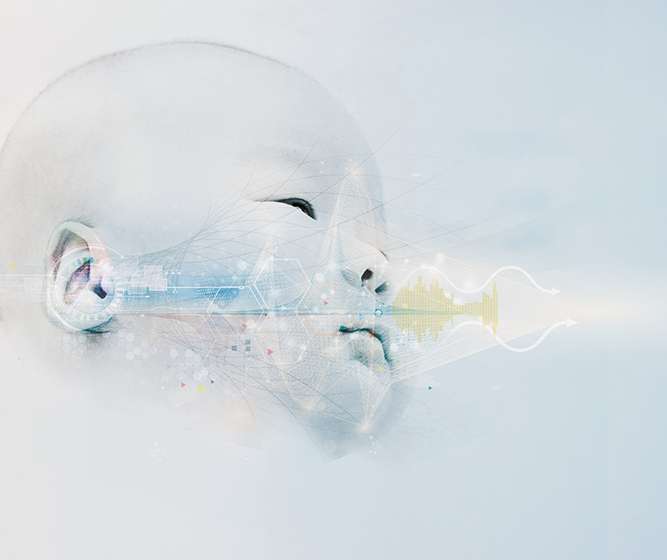A quest to find a better way to detect hearing problems in newborns takes researchers across the globe

In many states, it's mandatory to conduct hearing screenings on newborns. If hearing problems aren't diagnosed early, parents might not notice them until the child is a toddler.
"By the time they discover the child needs help, it may be too late," says Fuh-Cherng Jeng. "The time for language development starts early."
Jeng, an associate professor of communication sciences and disorders at Ohio University, argues that those early tests could be more rigorous to detect hearing deficiencies. The scientist and a team of graduate students recently discovered one way to bolster the screenings. Their research has shown that clinicians can look at brain wave scans to gauge whether newborns can respond to changes in speech intonation.
To conduct the study, Jeng proposed examining two populations of newborns. The first were easily accessible, as Jeng and his students already work with OhioHealth O'Bleness Hospital in Athens to offer hearing screenings for babies.
Working with the second population of newborns required a much more elaborate research endeavor. To gauge newborns' responses to inflections in languages other than English, Jeng reached out to the China Medical University in Taichung, Taiwan, where he previously worked as a physician. To conduct the research there, Jeng and his students would need to transport the research equipment by air and train colleagues who spoke no English.
The National Science Foundation awarded Jeng funding for the project to both advance the research and provide his graduate students with a unique international educational experience.
Grant Hollister journeyed to Asia twice for the project. The Ohio University graduate student and Dayton native says he didn't have much travel experience before he took the 36-hour trip. The students didn't have cell phones or much access to Wi-Fi, he recalls. The destination city of Taichung is modern but doesn't attract many American tourists; few locals spoke English.
"We didn't know any Mandarin Chinese words or phrases—we would take photos of food to restaurants so we could show the cooks what we wanted to order," Hollister says.
Teaching non-English-speaking nurses how to administer the hearing test to the newborns was a bigger challenge, Hollister notes. The Taiwanese staff watched the students carefully, and both groups used hand gestures and facial expressions to communicate whether they grasped the process or were confused, the student recalls.
The nurses mastered the equipment and ran the hearing tests on the Taiwanese newborns on their own after the American research team departed. Skype meetings allowed the Ohio University team to watch their progress from afar.
"It was a good feeling to be able to come into a country where we were so different, establish who we were and what our goals were, and have people trust us enough to help us advance the research, advance the science," Hollister notes.
Hollister and graduate student John Sabol traveled together for the 2013 research visits; students Mallory Marcis, Megan Presley, and Garrett Mayhugh made trips with Jeng during 2014.
The team not only fulfilled the educational goals of the project, but also came away from it with positive study findings. To perform the experiments, nurses attached small sensors to the newborns' heads. They played a recording of an adult speaking a sound with a variety of intonations. For the Taiwanese test, this was an "e" sound that, with four different Mandarin intonations, could either mean "clothing" (flat pitch), "aunt" (rising pitch), "chair" (dipping pitch), or "easy" (falling pitch), Jeng explains.
Research equipment tracked the babies' brain waves. Their reaction to the changes in intonation was small but significant, Jeng says, as the nurses had to play between 2,000 and 8,000 sounds to get one visible reaction.
"We were looking to tease out a teeny, tiny response," Jeng says.
But after weeding out electronic noise, the research team saw it. And they found the pattern consistent across the American and Taiwanese children.
"It confirms that we are born equal," Jeng says, no matter the native language of our birth environment.
After testing 55 babies in each of the two research sites, Jeng is seeking additional grant funding to continue to improve the research equipment to advance the work. In fall 2014, Ohio University offered Jeng and colleague Brandie Nance a Baker Award for the project.
As for Hollister, the international research experience made a lasting impact. Soon after his second trip to Taiwan, he had the opportunity to work at the Veterans Affairs Medical Center in San Francisco for four months. Although he says he previously would have written off the California job as too far from home, his Asian experience gave him new confidence.
"It did give me a different outlook on my life," he says. "It taught me to be a better team member and how important communication is—whether it's verbal or nonverbal. As far as my career, it pushed me to take myself out of my comfort zone and to embrace challenges."



















